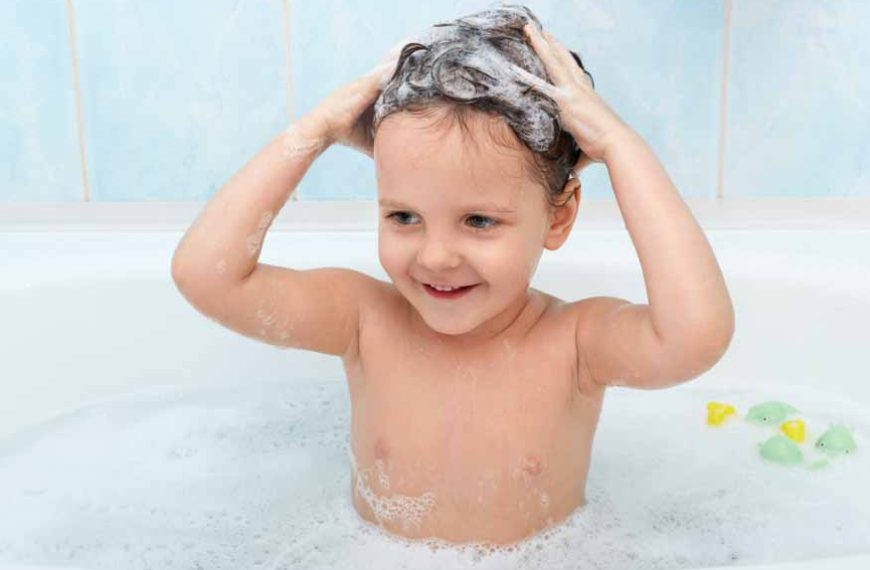As children grow older, teaching them how to bathe themselves is an important milestone. Taking on self-care skills boosts their confidence and self-esteem. With the right approach, your child can wash themselves completely independently by around age 6 or 7.
Learning independent bathing skills takes months of steady practice. As a parent, focus on encouraging and praising each small success to keep your child motivated as they tackle this new challenge. Break the larger goal of bathing solo into incremental steps that set them up for wins. Maybe first, they learn to properly lather the washcloth before washing. Then, they later graduate to rinsing shampoo from their hair. Build gradually, mastering one element at a time instead of expecting full self-sufficiency too fast.
With your guidance like patience, clear instruction, incentives, and highlighting what they do accomplish, soon your child will work up to confidently completing every bath time task by themselves. Maintain an upbeat, supportive tone even during temporary setbacks so they stay driven to achieve this key life milestone that boosts responsibility, problem-solving abilities, and self-esteem. Celebrate the moment they finally lather up, rinse off, and dry themselves independently from start to satisfied finish!
10 tips to successfully teach self-bathing skills
- Create a Kid-Friendly Environment:
- Establish a Consistent Routine :
- Demonstrate Proper Techniques :
- Do Dry Runs Before Adding Water : Have your child go through motions like scrubbing skin, shampooing hair, and squeezing out sudsy soap onto a washcloth without any water first. Role play likely scenarios like scooping up cups of water or playfully splashing each other to demonstrate what an active, lively bath time looks like before actually incorporating standing water they could slip in. Practicing the routine first builds confidence to try the real deal.
- Tackle One Area at A Time:
- Embrace Bath Time Fun :
- Stay Close By :
- Prioritize Key Tools :
- Provide Gentle Guidance :
- Offer Ongoing Praise :
Fill the tub with gentle cleansers, soft towels, and fun accessories like plastic boats, squirty toys, or rubber ducks. Install non-slip decals on the tub floor to prevent slippery falls. Having a welcoming atmosphere with familiar, comforting objects makes bathing enjoyable instead of intimidating for kids learning this new skill. Consider letting them pick out their favorite bubble bath or accessories to give them some ownership over creating this positive bath time atmosphere.
Set a predictable bath time, like 7:30 pm before bedtime every night, so the consistency sets clear expectations. Children thrive on set routines they can rely on. Knowing what to expect ahead of time with a regular, predictable bath schedule makes trying this important new skill less scary or nerve-wracking. Establishing a soothing pre-bath ritual, like reading a story or listening to music, signals it’s time to wash up.
Narrate your own bathing process, thoroughly explaining good habits like washing every inch of skin in a head to toe pattern. Describe why routines like fully lathering hair with shampoo and then carefully rinsing out all soap are so important for getting fully clean. Also, model other safe behaviors like using an indoor voice, walking carefully on wet tiles, and neatly hanging up used wet towels afterward to prevent slips.
Don’t expect total independence on early attempts. To start, assist with most of the bath, permitting them to try just one step themselves, like rinsing the legs, washing their feet, or wetting and soaping up their hair. Spotlight that solo completion moment as a huge celebratory confidence-building achievement! Talk up their effort and new skills as budding success. Offer a special treat afterward!
Allow giggling, safe splashing, independent play with colorful bath squirties, tub toys, and self-discovery during skills lessons. Bath time should be playful! Make getting clean fun by singing silly songs, identifying funny nicknames for slippery body parts, or making up imaginary adventure stories starring their favorite rubber ducky. A relaxed, lighthearted vibe reduces tension around trying this new milestone.
Sit within eyeshot, ready to cheer on effort, assist with difficult to reach spots or troubleshoot issues. But resist doing everything for them. Trial and error helps children better understand how to adjust motions to effectively wash all areas. Let them independently solve instead of swooping in, so they recognize solutions themselves.
Reduce extra toy distractions at first, so the focus stays on practicing using the fundamentals – gentle washcloths, fragrant soaps, and slippery shampoo. As their solo technique improves over weeks, gradually mix fun accessories like bath crayons or water-safe sticker books back into the routine once the basics are mastered.
Phrase any needed nudges as friendly suggestions instead of demands. For example, “I noticed you’re doing such a thorough job washing your arms. When you’re all done there, try splashing a little warm water on your tummy next!” This suggestive style promotes self motivation instead of embarrassment if they struggle with any tricky areas.
Completely independently learning bathing skills is tough. When needed, counter occasional irritability or frustration with spotlighting current achievements. Maybe they squirmed away when it came time to wash tangled hair but succeeded well at rinsing sudsy legs – that great try shows real traction! Recognizing little victories keeps morale and effort levels up. Make sure to celebrate the final victory of their first fully solo bath time!
The transition from needing full assistance with bathing to your child washing themselves requires monumental effort and skill growth for young kids. Expect this progression to take months of steady practice, not instant mastery overnight. There will be gradual milestones, like first learning to splash water on their legs before working up to fully shampooing hair alone. With your encouragement in celebrating small wins, plus your understanding when setbacks happen, your child will slowly gain courage and ability.
Provide clear examples, like demonstrating bath steps while narrating the why behind the proper technique. Resist doing everything for them even when it’s faster. Their path toward independence requires hands-on trial and error. Stay supportive of their effort and growing competence. Then, one day soon, the hard work will pay off, and your beaming, gloriously soapy child will revel in their new achievement of completing every bath time task confidently all by themselves!
For more such interesting blogs, Visit EuroKids

















